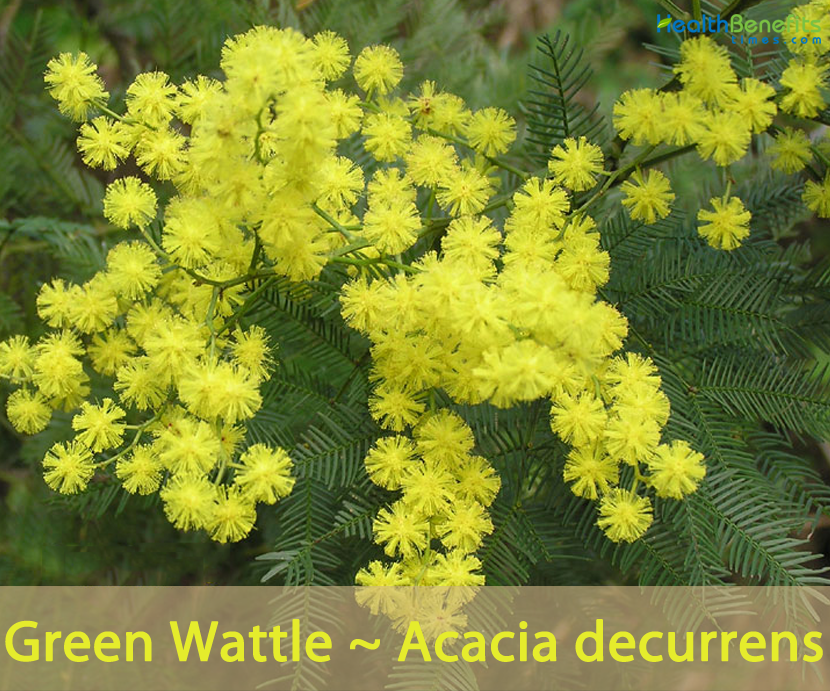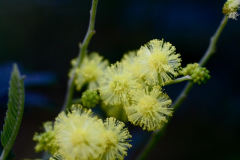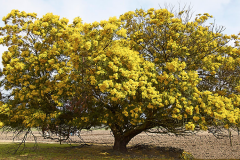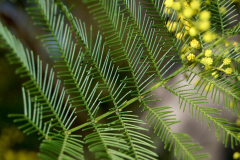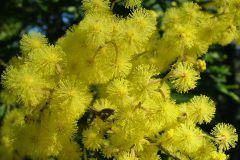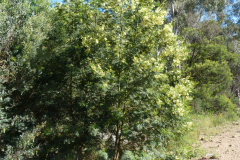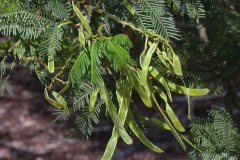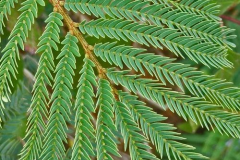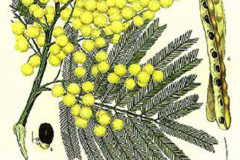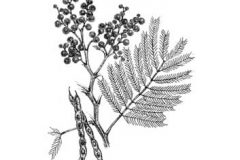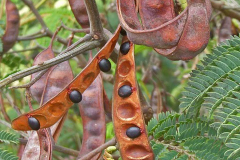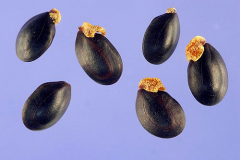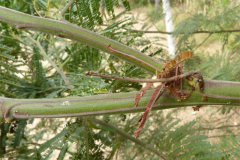The plant is harvested from the wild for local use as a food, medicine and source of materials. It is sometimes grown as a shade tree; for use as a source of tannins, wood, fuel, charcoal and pulp; and is also used for wind protection and as an ornamental, where it is valued especially for its floral display, in regions from the warm temperate to the tropical zone. The plant has become a serious weed problem in its native Australia, as well as elsewhere, including Hawaii, Colombia, New Zealand, Indonesia and South Africa.
Green Wattle Facts
| Green Wattle Quick Facts | |
|---|---|
| Name: | Green Wattle |
| Scientific Name: | Acacia decurrens |
| Origin | Eastern New South Wales, including Sydney, the Greater Blue Mountains Area, the Hunter Region, and south west to the Australian Capital Territory |
| Colors | Brown, red-brown or dark brown to black |
| Shapes | Elongated and somewhat flattened pod that is 20-105 mm long and 4-8.5 mm wide. These pods are usually slightly constricted between some or all of the seeds |
| Taste | Astringent |
| Health benefits | Treat wounds, skin problems, hemorrhoids, perspiring feet, eye problems, as a mouth wash, diarrhea and dysentery |
| Name | Green Wattle |
|---|---|
| Scientific Name | Acacia decurrens |
| Native | Eastern New South Wales, including Sydney, the Greater Blue Mountains Area, the Hunter Region, and south west to the Australian Capital Territory. In Victoria it is widely naturalized in the western and central parts of the state, and is particularly common north-east of Melbourne. Cultivated throughout Australia and in many other countries, Acacia decurrens has naturalized in most Australian states and in Africa, the Americas, Europe, New Zealand and the Pacific, the Indian Ocean area, and Japan |
| Common Names | Acacia bark, black wattle, Brazilian teak, early black wattle, golden teak, golden wattle, queen wattle, Sydney wattle, tan wattle, wattle bark, early green wattle, Sydney green wattle, King wattle, bark wattle, green wattle |
| Name in Other Languages | Afrikaans: Groenwattel Agewgna: Yeferenj Tsatsi Amargna: Akacha, Mimosa Arabic: Lha elkasya ( لحاء الأكاسيا), Akasya quenfa (أكاسيا قنفاء), sunt shayie (سنط شائع) Australia: Bark wattle, Sydney green wattle Brazil: Acácia preta, acácia-da-austrália, acácia-negra, black acacia British Indian Ocean Territory: Semai velampattai Chinese: Xian ye jin he huan (线叶金合欢) Czech: Akácie bílá Danish: Garve-Wattle Dutch: Zwarte rijswilg English: Black acacia, Black wattle, Common wattle, Early black wattle, Green wattle, Queen wattle, Sydney green wattle, Sydney wattle, Tan wattle, Sydney black wattle Estonian: Sindi akaatsia, Sulgakaatsia French: Acacia noir, faux mimosa, mimosa d’hiver German: Mimose der Gärtner, Schwarze Akazie, Australische Silber-Akazie Hindi: Hara babul, peek jyali Italian: Acacia nera, mimosa nera Japanese: Akakia dekurensu (アカキア・デ クレンス), Mimosaakashia (ミモサアカシア) Malayalam: Paccavāṟṟil (പച്ചവാറ്റിൽ) Netherlands: Zwarte rijswilg Persian: آکاکیا دکارنس Portuguese: Acácia-australiana, Acácia-mimosa, Acácia negra, Acácia-prateada, Mimosa-prateada Puerto Rico: Aromo negro Russian: Akatsiia nizbegaiushchaia (Акация низбегающая) South Africa: Groenwattel Spanish: Acacia decurrente, acacia escurrida, acacia negra, acacia verde Swedish: Grönakacia Ukrainian: Akatsiya nizbehayushcha (Акація нізбегающа) |
| Plant Growth Habit | Woody flowering shrub or tree |
| Growing Climates | Sheltered forests, mainly on shales, sandstone, cool moist hills, gullies, coastal hinterlands, coastal ranges, lower tablelands, eucalypt forests, woodlands, heathlands, hillsides, riverbanks, roadsides, creeklines, nearby bush lands, waste areas, rainforests, grasslands, coastal dunes and deserts |
| Soil | Prefers deep soils that are light to medium and free draining. It occurs naturally on soils of only moderate fertility: acid and neutral yellow earths, acid-bleached red duplex soils, podsols, and some brown friable earths derived principally from shales. The species also occurs on basalt-derived soils |
| Plant Size | 5-15 m tall but sometimes attains 20-22 m under favorable conditions |
| Bark | Bark is brown to dark grey color and smooth to deeply fissured longitudinally with conspicuous intermodal flange marks |
| Branchlets | Branchlets have longitudinal ridges running along them that are unique to the species. Young foliage tips are yellow |
| Leaf | Leaves are twice-compound (i.e. bipinnate) and dark green on both sides. These leaves are 5-15 cm long and are alternately arranged along the stems and are stalked (i.e. petiolate). The leaf stalk is 7-35 mm long and is ridged, generally hairless (i.e. glabrous), and usually bears a prominent raised structure (i.e. gland). This gland is almost round in shape, usually found towards the base of the leaf stalk, and is always more than 7 mm below the lowest pair of leaf branchlets |
| Flowering season | July to September |
| Flower | The small yellow or golden-yellow flowers are very fluffy in appearance and are densely arranged into small globular clusters (4-7 mm across). These flowers have five relatively inconspicuous petals and sepals and numerous conspicuous stamens. The globular flower clusters each contain numerous (20-32) flowers and are borne on short stalks (i.e. peduncles) 2-7 mm long. They are arranged along a small branch emanating from the forks (i.e. axils) of the leaves, or occasionally borne at the tips of the stems. |
| Fruit Shape & Size | Elongated and somewhat flattened pod that is 20-105 mm long and 4-8.5 mm wide. These pods are usually slightly constricted between some or all of the seeds |
| Fruit Color | Brown, red-brown or dark brown to black |
| Seed | Seeds are about 3-4 mm long which have a small fleshy structure (i.e. aril) attached to them. |
| Propagation | By seed and root suckers |
| Taste | Astringent |
| Plant Parts Used | Bark |
| Season | November- January |
| Lifespan | Live for 15–50 years |
Plant Description
Green Wattle is a woody flowering shrub or small tree that normally grows about 5-15 m tall but sometimes attains 20-22 m under favorable conditions. The plant is found growing in sheltered forests, mainly on shales, sandstone, cool moist hills, gullies, coastal hinterlands, coastal ranges, waste areas, lower tablelands, eucalypt forests, woodlands, heathlands, hillsides, riverbanks, roadsides, creek lines, nearby bush lands, rainforests, grasslands, coastal dunes and deserts. The plant prefers deep soils that are light to medium and free draining. It occurs naturally on soils of only moderate fertility: acid and neutral yellow earths, acid-bleached red duplex soils, pod sols, and some brown friable earths derived principally from shales. The species also occurs on basalt-derived soils.
Stems
The bark of older stems is fissured and brown, dark grey or black in color. Younger stems have smooth bark and the branches have conspicuous wings or ridges (0.5-2 mm high) that emanate from the leaf bases (i.e. they are decurrent). These branches are hairless (i.e. glabrous), or sparsely covered in very small hairs (i.e. puberulent), and the young foliage-tips are yellowish-green or yellow in color.
Leaves
Leaves are twice-compound (i.e. bipinnate) and dark green on both sides. These leaves are 5-15 cm long and are alternately arranged along the stems and are stalked (i.e. petiolate). The leaf stalk is 7-35 mm long and is ridged, generally hairless (i.e. glabrous), and usually bears a prominent raised structure (i.e. gland). This gland is almost round in shape, usually found towards the base of the leaf stalk, and is always more than 7 mm below the lowest pair of leaf branchlets (i.e. pinnae). The extension of the leaf stalk (i.e. rachis) bears several to numerous (3-15) pairs of leaf branchlets (i.e. pinnae). It is 2-12 cm long, generally hairless (i.e. glabrous), and bears a small raised structure (i.e. gland) at the junction of the each of the pairs of leaf branchlets (i.e. pinnae). The leaf branchlets are 25-90 mm long and have numerous (15-45) pairs of widely-spaced leaflets (i.e. pinnules). These leaflets are 5-15 mm long and only 0.3-1 mm wide and are linear in shape, mostly hairless (i.e. glabrous), and have rounded or somewhat pointed tips (i.e. obtuse to sub-acute apices).
Flowers
The small yellow or golden-yellow flowers are very fluffy in appearance and are densely arranged into small globular clusters (4-7 mm across). These flowers have five relatively inconspicuous petals and sepals and numerous conspicuous stamens. The globular flower clusters each contain numerous (20-32) flowers and are borne on short stalks (i.e. peduncles) 2-7 mm long. They are arranged along a small branch emanating from the forks (i.e. axils) of the leaves, or occasionally borne at the tips of the stems. These branches may or may not be further branched (i.e. they form inflorescences resembling racemes or panicles). Flowering generally occurs during late winter and early spring (i.e. from July to September).
Fruit
Fertile flowers are followed by an elongated and somewhat flattened pod that is 20-105 mm long and 4-8.5 mm wide. These pods are usually slightly constricted between some or all of the seeds and turn brown or dark brown in color as they mature. They are initially hairy but they become hairless (i.e. glabrous), smooth in texture as they grow, and are normally present during late spring and summer (i.e. from November to January). Each pod contains several seeds that are about 3-4 mm long which have a small fleshy structure (i.e. aril) attached to them.
Green Wattle is used in chemical products, environmental management, and wood. The flowers are edible and are used in fritters. An edible gum oozing from the tree’s trunk can be used as a lesser-quality substitute for gum Arabic, for example in the production of fruit jelly. The bark consists of about 37–40% tannin. The flowers are used to produce yellow dye, and the seed pods are used to produce green dye. An organic chemical compound called kaempferol gives the flowers of Acacia decurrens their color. It has been grown for firewood, or as a fast-growing windbreak or shelter tree.
Traditional uses and benefits of Green Wattle
- The bark is astringent. It should be stored for 12 months before being used.
- They are used in the treatment of diarrhea and dysentery, and can also be helpful in cases of internal bleeding.
- Applied externally, often as a wash, they are used to treat wounds and other skin problems, hemorrhoids, perspiring feet, some eye problems, as a mouth wash etc.
Culinary Uses
- Flowers can be consumed after being cooked.
- They are often used in fritters.
- Gum that exudes naturally from the trunk is edible and is used as a substitute for Gum Arabic in making jellies etc.
- It can be sucked like candy or soaked in water to make a jelly.
- The gum can be warmed when it becomes soft and chewable.
Other Facts
- A yellow dye is obtained from the flowers.
- A green dye is obtained from the seed pods.
- The extensive root system of this plant helps to prevent soil erosion.
- It is often grown as a screen in Australia.
- The bark contains about 40% tannin.
- It is cultivated for use as an ornamental, soil improver, shade and shelter tree, tannin source, paper fiber source, fuel wood and charcoal.
- It has been used for windbreaks, shelterbelts, as a shade crop and for soil stabilization.
- In Sri Lanka, it was introduced by tea planters around the 1870s and widely used for hedges, shelterbelts and windbreaks, as a shade tree, for green manure and fuel wood production.
- The wood has been used for building poles, mine props, fence posts and hardboard production.
- Acacia decurrens has the potential to be an excellent source of fuel wood.
- Leaves have also been used for green manure production.
- decurrens is not known for its fodder value in Australia.
- It is insoluble in water.
- The seeds yield pale-brown fatty oil.
- They have high oil content with potential for use as a drying oil.
- Dyes extracted from the leaves have been used to color wool yellow or green depending on the mordant used.
References:
https://www.itis.gov/servlet/SingleRpt/SingleRpt?search_topic=TSN&search_value=182078#null
https://npgsweb.ars-grin.gov/gringlobal/taxon/taxonomydetail?id=822
https://pfaf.org/user/Plant.aspx?LatinName=Acacia+decurrens
https://www.cabi.org/isc/datasheet/2208
https://en.wikipedia.org/wiki/Acacia_decurrens
https://gd.eppo.int/taxon/ACADC
http://www.theplantlist.org/tpl1.1/record/ild-390
https://keyserver.lucidcentral.org/weeds/data/media/Html/acacia_decurrens.htm
https://plantnet.rbgsyd.nsw.gov.au/cgi-bin/NSWfl.pl?page=nswfl&lvl=sp&name=Acacia~decurrens
https://tropical.theferns.info/viewtropical.php?id=Acacia+decurrens
https://apps.lucidcentral.org/wattle/text/entities/acacia_decurrens.htm
https://plants.usda.gov/home/plantProfile?symbol=ACDE


